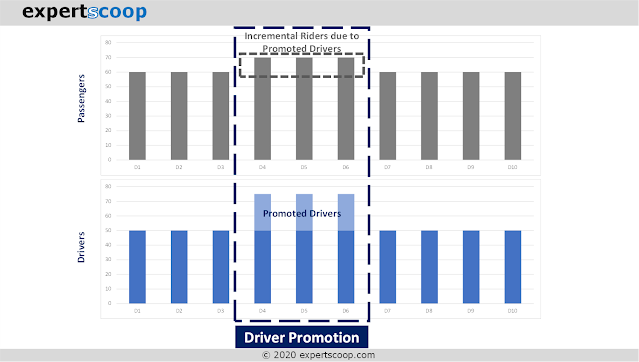Let’s talk about two-sided marketplace promotions.
More specifically, the crucial marketing tactic two-sided marketplace platforms, such as Uber or Doordash, deploy to drive engagement and growth by stimulating both demand and supply among their network participants.
The last five years have given rise to the ‘aggregator platform’ business model, resulting in the meteoric growth of ‘two-sided marketplace’ companies, such as Uber or Airbnb or Doordash. These asset-lite network players go beyond the traditional Business-to-Business (B2B) and Business-to-Consumer (B2C) models – they create value by connecting fragmented suppliers and fragmented customers onto the same platform and facilitating a frictionless matching and transaction process between buyers and sellers.
Traditional companies spend marketing dollars to acquire customers and design supply chains based on existing demand. Two-sided marketplaces, on the other hand, must market both to suppliers and customers, often needing to make trade-offs with regard to where they spend their promotions budgets.
Let’s take Uber for example. On a $100 car ride, $80 goes to the driver and Uber keeps $20 as margin on average. However, depending on the specific market, Uber can choose to either reduce the price of the ride to the consumer or pay the driver extra.
Here is an approach (see Figure 1) to how marketplaces can evaluate the trade-offs between investing marketing promo dollars in supply vs. demand-side incentives.
Figure 1. The 4-Step Optimization Cycle for Two-Sided Marketplace Promotions
Since customer and supplier acquisition is central to the working of a two-sided marketplace, it is essential that core functional leaders align on the maximum spend the company is willing to commit to acquisition. Possible opportunity costs may come from Brand Development, Product Development, Research, and Investor Payouts.
Companies in an earlier stage of growth tend to prioritize growth over margins and often spend more on promotions than larger, more established brands.
2. Assess Market Constraints
Two-sided marketplaces are unique in having to manage market constraints dynamically, often in real time. A demand constraint suggests that there are insufficient customers for the existing supply. Signs of this include: underutilized supply, for example, drivers having large idle times between pick-ups. As a result, underutilized drivers may join another network or drop off the grid altogether, resulting in lost revenue potential.
On the other hand, a supply constraint occurs when there is not enough supply to serve pent-up demand that exists. Signs of this could be: large incidence of customer requests going unfulfilled, or long wait times between ride order and pick-up. Underserved customers will abandon the platform altogether and likely switch to a competitor or a legacy player.
The marketplace company needs to address the constraint in each market. Promotional dollars are likely better spent on incentivizing suppliers during a supply constraint, and to attract customers in times of a demand constraint.
3. Measure Price Sensitivity
Once the target is decided, it is critical to assess how sensitive they are to price. Companies should A/B test multiple promotions and assess incremental revenue resulting from the promotion.
An important consideration is that a supply-side promotions also must be evaluated against increase in net revenue. This is because the end goal of a supplier promotion, as with all demand-side promotions, is to increase customer revenues – in this case, by increasing supply.
2. Assess Market Constraints
Two-sided marketplaces are unique in having to manage market constraints dynamically, often in real time. A demand constraint suggests that there are insufficient customers for the existing supply. Signs of this include: underutilized supply, for example, drivers having large idle times between pick-ups. As a result, underutilized drivers may join another network or drop off the grid altogether, resulting in lost revenue potential.
On the other hand, a supply constraint occurs when there is not enough supply to serve pent-up demand that exists. Signs of this could be: large incidence of customer requests going unfulfilled, or long wait times between ride order and pick-up. Underserved customers will abandon the platform altogether and likely switch to a competitor or a legacy player.
The marketplace company needs to address the constraint in each market. Promotional dollars are likely better spent on incentivizing suppliers during a supply constraint, and to attract customers in times of a demand constraint.
3. Measure Price Sensitivity
Once the target is decided, it is critical to assess how sensitive they are to price. Companies should A/B test multiple promotions and assess incremental revenue resulting from the promotion.
An important consideration is that a supply-side promotions also must be evaluated against increase in net revenue. This is because the end goal of a supplier promotion, as with all demand-side promotions, is to increase customer revenues – in this case, by increasing supply.
Figure 3. Scenario B – Drivers Given Promotion to Reduce Wait Time for Customers
4. Optimize Using Feedback from Acquisition
Perhaps the most important step in the framework is to ensure lessons from the other three phases are studied and incorporated into future promotions. Areas of potential impact include:
- People and process changes as a result of having to manage larger business scale or functional improvements,
- Alignment on possible promotion and margin guardrails based on known demand side, supply side, and investor sensitivity,
- Product features to automate constraint assessment and setting up flash promotions to bring in incremental revenue when needed.
Two-sided marketplaces are a powerful business model that offer strong value proposition by serving both supply-side providers and demand-side customer by connecting them onto a flexible and dynamic platform. To drive engagement and growth, they have to simultaneously be masterful B2C and B2B marketers, which requires them to perfect the 4-step optimization flywheel to strike the right balance between supplier and customer promotions that maximize marketplace revenues and platform user retention.










No comments:
Post a Comment